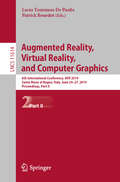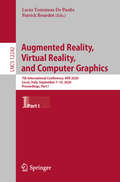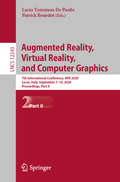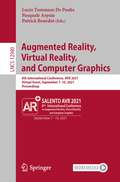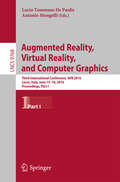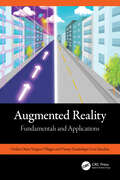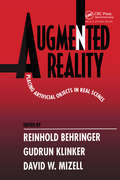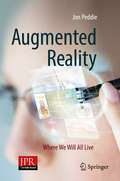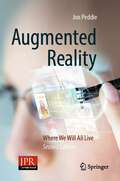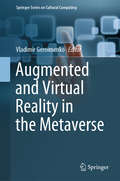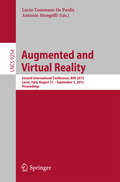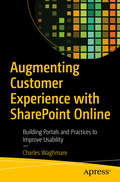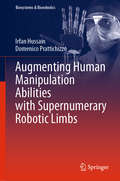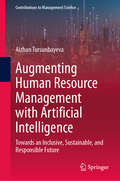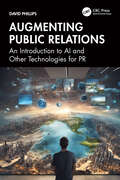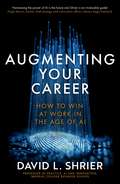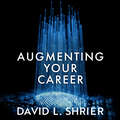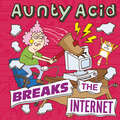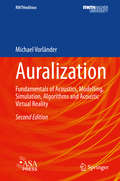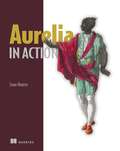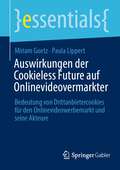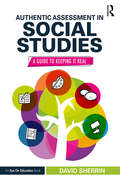- Table View
- List View
Augmented Reality, Virtual Reality, and Computer Graphics: 6th International Conference, AVR 2019, Santa Maria al Bagno, Italy, June 24–27, 2019, Proceedings, Part II (Lecture Notes in Computer Science #11614)
by Lucio Tommaso De Paolis Patrick BourdotThe 2-volume set LNCS 11613 and 11614 constitutes the refereed proceedings of the 6th International Conference on Augmented Reality, Virtual Reality, and Computer Graphics, AVR 2019, held in Santa Maria al Bagno, Italy, in June 2019.The 32 full papers and 35 short papers presented were carefully reviewed and selected from numerous submissions. The papers discuss key issues, approaches, ideas, open problems, innovative applications and trends in virtual and augmented reality, 3D visualization and computer graphics in the areas of medicine, cultural heritage, arts, education, entertainment, military and industrial applications. They are organized in the following topical sections: virtual reality; medicine; augmented reality; cultural heritage; education; and industry.
Augmented Reality, Virtual Reality, and Computer Graphics: 7th International Conference, AVR 2020, Lecce, Italy, September 7–10, 2020, Proceedings, Part I (Lecture Notes in Computer Science #12242)
by Lucio Tommaso De Paolis Patrick BourdotThe 2-volume set LNCS 12242 and 12243 constitutes the refereed proceedings of the 7th International Conference on Augmented Reality, Virtual Reality, and Computer Graphics, AVR 2020, held in Lecce, Italy, in September 2020.* The 45 full papers and 14 short papers presented were carefully reviewed and selected from 99 submissions. The papers discuss key issues, approaches, ideas, open problems, innovative applications and trends in virtual reality, augmented reality, mixed reality, 3D reconstruction visualization, and applications in the areas of cultural heritage, medicine, education, and industry. * The conference was held virtually due to the COVID-19 pandemic.
Augmented Reality, Virtual Reality, and Computer Graphics: 7th International Conference, AVR 2020, Lecce, Italy, September 7–10, 2020, Proceedings, Part II (Lecture Notes in Computer Science #12243)
by Lucio Tommaso De Paolis Patrick BourdotThe 2-volume set LNCS 12242 and 12243 constitutes the refereed proceedings of the 7th International Conference on Augmented Reality, Virtual Reality, and Computer Graphics, AVR 2020, held in Lecce, Italy, in September 2020.*The 45 full papers and 14 short papers presented were carefully reviewed and selected from 99 submissions. The papers discuss key issues, approaches, ideas, open problems, innovative applications and trends in virtual reality, augmented reality, mixed reality, 3D reconstruction visualization, and applications in the areas of cultural heritage, medicine, education, and industry. * The conference was held virtually due to the COVID-19 pandemic.
Augmented Reality, Virtual Reality, and Computer Graphics: 8th International Conference, AVR 2021, Virtual Event, September 7–10, 2021, Proceedings (Lecture Notes in Computer Science #12980)
by Lucio Tommaso De Paolis Patrick Bourdot Pasquale ArpaiaThis book constitutes the refereed proceedings of the 8th International Conference on Augmented Reality, Virtual Reality, and Computer Graphics, AVR 2021, held in Italy, in September 2021. Due to COVID-19 pandemic the conference was held virtually. The 38 full and 14 short papers were carefully reviewed and selected from 69 submissions. The papers discuss key issues, approaches, ideas, open problems, innovative applications and trends in virtual reality, augmented reality, mixed reality, applications in cultural heritage, in medicine, in education, and in industry.
Augmented Reality, Virtual Reality, and Computer Graphics: Third International Conference, AVR 2016, Lecce, Italy, June 15-18, 2016. Proceedings, Part I (Lecture Notes in Computer Science #9768)
by Lucio Tommaso De Paolis Antonio MongelliThe 2-volume set LNCS 9768 and 9769 constitutes the refereed proceedings of the Third International Conference on Augmented Reality, Virtual Reality and Computer Graphics, AVR 2016, held in Lecce, Italy, in June 2016. The 40 full papers and 29 short papers presented werde carefully reviewed and selected from 131 submissions. The SALENTO AVR 2016 conference intended to bring together researchers, scientists, and practitioners to discuss key issues, approaches, ideas, open problems, innovative applications and trends on virtual and augmented reality, 3D visualization and computer graphics in the areas of medicine, cultural heritage, arts, education, entertainment, industrial and military sectors.
Augmented Reality: Fundamentals and Applications
by Osslan Osiris Vergara Villegas Vianey Guadalupe Cruz SánchezThis book focuses on augmented reality (AR) technology, which uses the real environment to superimpose virtual elements. Therefore, the reader can create applications that simulate scenarios that can be dangerous or expensive to generate in the real world. AR has proven helpful in education, marketing, and industrial scenarios. AR technology improves the user experience of various disciplines, incorporating virtual information that maximizes the experience and adds knowledge. This book intends students, researchers, and developers to have the possibility of finding the foundations on which AR technology rests.Our book intends that students, researchers, and developers: (i) learn the basics of AR; (ii) understand the technologies that support AR; (iii) know about AR applications that have been a watershed; (iv) gain an understanding of the critical elements needed to implement an AR application; (v) acquire skill in the step-by-step development of an AR application; (vi) learn how to use the instruments to evaluate an AR application; (vii) understand how to present the information about study cases; and (viii) gain knowledge about AR challenges and trends.
Augmented Reality: Placing Artificial Objects in Real Scenes
by Gudrun Klinker Reinhold Behringer David W. MizellThis book presents a variety of techniques that combine computer-generated images and other objects with real scenes, creating augmented reality. This work provides an excellent snapshot of the current state of augmented reality research and its latest applications to industry. Using computer vision, graphics, and signal processing, augmented reali
Augmented Reality: Where We Will All Live
by Jon PeddieThis book provides an in-depth exploration of the field of augmented reality (AR) in its entirety and sets out to distinguish AR from other inter-related technologies like virtual reality (VR) and mixed reality (MR). The author presents AR from its initial philosophies and early developments, to its current technologies and its impact on our modern society, to its possible future developments; providing readers with the tools to understand issues relating to defining, building, and using our perception of what is represented in our perceived reality, and ultimately how we assimilate and react to this information. Augmented Reality: Where We Will All Live can be used as a comprehensive guide to the field of AR and provides valuable insights for technologists, marketers, business managers, educators and academics who are interested in the field of augmented reality; its concepts, history, practices and the science behind this rapidly advancing field of research and development.
Augmented Reality: Where We Will All Live
by Jon PeddieThis book provides an in-depth exploration of the field of augmented reality (AR) in its entirety and sets out to distinguish AR from other inter-related technologies like virtual reality (VR), mixed reality (MR) and extended reality (XR). The author presents AR from its initial philosophies and early developments, and in this updated 2nd edition discusses the latest advances and the ramifications they bring and the impact they have on modern society. He examines the new companies that have entered the field and those that have failed or were acquired giving a complete history of AR progress. He explores the possible future developments providing readers with the tools to understand issues relating to defining, building, and using their perception of what is represented in their perceived reality, and ultimately how we assimilate and react to this information. In Augmented Reality: Where We Will All Live 2nd Edition, Jon Peddie has amassed and integrated a corpus of material that is finally in one place. It will serve as a comprehensive guide and provide valuable insights for technologists, marketers, business managers, educators and academics who are interested in the field of augmented reality, its concepts, history, practices, and the science behind this rapidly advancing field of research and development.
Augmented and Mixed Reality for Communities
by Joshua A. FisherUsing mixed and augmented reality in communities is an emerging media practice that is reshaping how we interact with our cities and neighbors. From the politics of city hall to crosswalks and playgrounds, mixed and augmented reality will offer a diverse range of new ways to interact with our communities. In 2016, apps for augmented reality politics began to appear in app stores. Similarly, the blockbuster success of Pokémon Go illustrated how even forgotten street corners can become a magical space for play. In 2019, a court case in Milwaukee, Wisconsin, extended first amendment rights to augmented reality. For all the good that these emerging media provide, there will and have been consequences. Augmented and Mixed Reality for Communities will help students and practitioners navigate the ethical design and development of these kinds of experiences to transform their cities. As one of the first books of its kind, each chapter in the book prepares readers to contribute to the Augmented City. By providing insight into how these emerging media work, the book seeks to democratize the augmented and mixed reality space.Authors within this volume represent some of the leading scholars and practitioners working in the augmented and mixed reality space for civic media, cultural heritage, civic games, ethical design, and social justice. Readers will find practical insights for the design and development to create their own compelling experiences. Teachers will find that the text provides in-depth, critical analyses for thought-provoking classroom discussions.
Augmented and Virtual Reality in the Metaverse (Springer Series on Cultural Computing)
by Vladimir GeroimenkoThis is the first research monograph to explore augmented and virtual reality in the context of the emerging metaverse, and their impact on the future of education, culture, art, society, heritage, healthcare, and other areas. It reveals how the two metaverse-enabling technologies are changing the world we live in by changing the educational experience, by influencing art, culture, and society, and by engaging artificial intelligence and other advanced technologies. Dealing with a wide range of topics, it includes: possible metaverses for education; designing simulations and effective learning environments in the educational metaverse; immersive collaborative learning; storytelling and cinematic virtual reality in metaverses; immersion and sensory enrichment in the metaverse; archaeology of perception in metaverse environments; integrating AI and Large Language Models with immersive technologies; AR-enabled X-ray vision in immersive environments; metaverse-based approaches in urban planning; and many others. Written by a team of 46 researchers, practitioners, and artists from 11 countries world-wide (Australia, China, Estonia, Germany, Greece, Italy, Norway, Romania, Serbia, Spain, and USA), it offers readers an international perspective. Intended as a starting point for exploring augmented and virtual reality in the metaverse context, this book will be essential reading not only for researchers, practitioners, technology developers, and artists, but also for students (graduates and undergraduates), and for anyone interested in the emerging fields of “metaverse augmented reality” and “metaverse virtual reality”.
Augmented and Virtual Reality: Second International Conference, AVR 2015, Lecce, Italy, August 31 - September 3, 2015, Proceedings (Lecture Notes in Computer Science #9254)
by Lucio Tommaso De Paolis Antonio MongelliThis book constitutes the refereed proceedings of the Second International Conference on Augmented and Virtual Reality, AVR 2015, held in Lecce, Italy, in September 2015. The 32 papers and 8 short papers presented were carefully reviewed and selected from 82 submissions. The SALENTO AVR 2015 conference brings together a community of researchers from academia and industry, computer scientists, engineers, and physicians in order to share points of views, knowledge, experiences, and scientific and technical results related to state-of-the-art solutions and technologies on virtual and augmented reality applications for medicine, cultural heritage, education, industrial sectors, as well as the demonstration of advanced products and technologies.
Augmented: prAIority to Enhance Human Judgment through Data and AI
by Giulio ToscaniIn a world where artificial intelligence is reshaping industries, how can we ensure that AI enhances human skills rather than replacing them? This book offers readers an accessible and insightful guide to the positive potential of AI for human augmentation.Drawing from consultations with 150 AI experts from across 50 countries, Augmented introduces the concept of "prAIority", which connects three essential pillars: data, AI systems, and human judgment. It examines how data fuels innovation, the intricacies of designing and refining AI systems, and the critical role of human expertise in harnessing AI’s strengths. Breaking down complex ideas, this book equips readers with the knowledge to understand how AI can be integrated into their decision-making processes, ultimately empowering them to achieve better outcomes in diverse fields such as healthcare, design, and business.With a focus throughout on human–AI collaboration rather than automation and on seamless integration—for smarter, faster decisions, and innovation—this is a must-read book for professionals looking to enhance their skills and stay ahead in the AI-driven future as well as curious beginners seeking a clear framework.
Augmenting Customer Experience with SharePoint Online: Building Portals and Practices to Improve Usability
by Charles WaghmareBuild, enrich, and transform customer experience using SharePoint Online. This book will discuss different SharePoint Online approaches that you can use to enhance customer experience, including digital portals, enterprise content management, Microsoft Teams and much more. Augmenting Customer Experience with SharePoint Online starts with an introduction to SharePoint Online features you can adopt to create better digital customer experience and transformation. Next, you will learn about augmentation for user and customer experience followed by guidelines and methods to develop smart and intelligent portals. Moving forward, you will cover enterprise and web content management in detail along with the challenges and benefits of using SharePoint Online. The partner ecosystem is discussed next with a detailed discussion on working with suppliers, partners, and vendors. Along the way, you will see how to create smart solutions using SharePoint Online and how to manage customer references. Finally, you will go through the use of SharePoint Online in different business sectors with the help of case studies. After reading the book, you will be able to adopt SharePoint Online features to augment customer and user experience. What You Will Learn Augment customer experience Create smart and intelligent portals for various business needs Efficiently manage enterprise and web content Enhance your partner ecosystem for better collaboration Build SharePoint Online solutions Who This Book Is For Anyone wanting to adopt SharePoint Online to develop portals, content management systems, knowledge hubs, reference captures, or online foundries.
Augmenting Human Manipulation Abilities with Supernumerary Robotic Limbs (Biosystems & Biorobotics #26)
by Domenico Prattichizzo Irfan HussainThis book offers a timely report on an emerging topic in the field of wearable assistive technology: the design and development of robotic extra fingers. After a concise review of the state of the art and a description of earlier prototypes, it discusses the authors’ efforts to address issues such as portability and wearability of the devices, including strategies to reduce fatigue and to integrate the motion of the extra fingers with that of the human hand. The book also explores optimized control algorithms and the design of wearable sensorimotor interfaces, and presents a set of tests carried out on healthy subjects and chronic stroke patients. Merging concepts from robotics, biomechanics, human factors and control theory and offering an overview of supernumerary robotic fingers, including the challenges, this book will inspire researchers involved in the development of wearable robotic devices and interfaces based on the principles of wearability, safety, ergonomics and user comfort.
Augmenting Human Resource Management with Artificial Intelligence: Towards an Inclusive, Sustainable, and Responsible Future (Contributions to Management Science)
by Aizhan TursunbayevaThe potential of Artificial Intelligence (AI) to reshape Human Resource Management (HRM) practices is profound, but it also presents challenges that require careful consideration, particularly in terms of ethics, inclusivity, and sustainability. However, knowledge about whether and how this transformation is actually occurring remains limited. This book aims to provide a theoretically informed and empirically grounded examination of AI's role in shaping the future of HRM and work. The book explores HRM technologies using a configurational approach, which views HRM practices as a blend of operational, relational, and transformational elements. It consistently addresses the dual perspectives on AI—its transformative potential and the concerns surrounding its disruptive impact on the future of work and management. In doing so, the book draws on ongoing original research, including an analysis of vendors' value propositions and insights from scholars and experts. Real-life applications of AI in HRM are also thoroughly covered, offering insights into algorithmic management, AI-driven relational HRM configurations, and AI-augmented HRM. The book dedicates significant attention to the ethical implications of AI and how they can be addressed through Responsible AI principles. Ultimately, it establishes a framework for future research and practice, serving as a crucial reference for scholars, practitioners, and policymakers.
Augmenting Public Relations: An Introduction to AI and Other Technologies for PR
by David PhillipsAugmenting Public Relations examines how existing technologies used in Public Relations (PR) are being significantly augmented because of the advent of Artificial Intelligence (AI). The book describes the opportunities and pitfalls of AI, recent and emerging technologies, and projections in their development, offering an introduction to practitioners on how they, too, can create their own AI-enhanced tools.The developments in augmented, virtual and meta-reality, aided by AI, have now become serious contenders for commercial communication, and the ability to harness this visual capability is explained in some detail. As is the ability for practitioners to automatically monitor and feed websites using Application Programming Interfaces (APIs). The book also considers computer games as a form of communication, and the evolving application of games supported by AI. In recent years, the PR monitoring industry has deployed AI to search for content of interest to clients across a vast range of media. It throws up huge amounts of data to be managed. The book explores how such resources can be harnessed for intelligence gathering and activity deployment in easy-to-understand language. The book also covers a range of other activities from ‘brain to computer communication’ to chatbots, including applications used by the Internet of Things, Security Issues and Crisis Management, and the crucial subject of Ethics.Examining a range of new practices for the PR industry, and covering both principles and applications, this book will be of great value to students, academics and practitioners alike.
Augmenting Your Career: How to Win at Work In the Age of AI
by David ShrierEssential reading for anyone who wants to be relevant in the workforce of tomorrow.Drawing on more than a decade of research on artificial intelligence and human systems, David L. Shrier, a globally recognised futurist and innovation specialist, delivers fascinating insights and tips on how to win at work in the age of AI. Artificial intelligence is driving workforce disruption on a scale not seen since the Industrial Revolution. Automation was once associated with mass layoffs in heavy industry like auto and steel, but computers are getting smarter and are beginning to replace traditionally 'white collar' roles like law, consulting, banking and finance.Yet some curious findings are emerging from the world's leading research labs. The combined intellect of people and machines working in harmony is able to achieve outcomes that are better than either can accomplish alone. Properly tuned AI systems can even help harness the power of the collective intelligence of an entire organisation or community to predict future events. This isn't science fiction; this is science fact the author personally helped discover.What are these new hybrid AI+people systems? What can specialised AI systems do to help you succeed in your career? How can you work most effectively with these machines?Written by a practitioner who has worked with some of the largest companies in the world as well as some of the most innovative startups, Augmenting Your Career provides a rare window into a frontier area of computer science that will change everything about how you work and what your job will look like. Read this book and fast track your evolution to the knowledge worker of the future.
Augmenting Your Career: How to Win at Work In the Age of AI
by David ShrierEssential reading for anyone who wants to be relevant in the workforce of tomorrow.Drawing on more than a decade of research on artificial intelligence and human systems, David L. Shrier, a globally recognised futurist and innovation specialist, delivers fascinating insights and tips on how to win at work in the age of AI. Artificial intelligence is driving workforce disruption on a scale not seen since the Industrial Revolution. Automation was once associated with mass layoffs in heavy industry like auto and steel, but computers are getting smarter and are beginning to replace traditionally 'white collar' roles like law, consulting, banking and finance.Yet some curious findings are emerging from the world's leading research labs. The combined intellect of people and machines working in harmony is able to achieve outcomes that are better than either can accomplish alone. Properly tuned AI systems can even help harness the power of the collective intelligence of an entire organisation or community to predict future events. This isn't science fiction; this is science fact the author personally helped discover.What are these new hybrid AI+people systems? What can specialised AI systems do to help you succeed in your career? How can you work most effectively with these machines?Written by a practitioner who has worked with some of the largest companies in the world as well as some of the most innovative startups, Augmenting Your Career provides a rare window into a frontier area of computer science that will change everything about how you work and what your job will look like. Read this book and fast track your evolution to the knowledge worker of the future.
Augmenting Your Career: How to Win at Work In the Age of AI
by David ShrierEssential reading for anyone who wants to be relevant in the workforce of tomorrow.Drawing on more than a decade of research on artificial intelligence and human systems, David L. Shrier, a globally recognised futurist and innovation specialist, delivers fascinating insights and tips on how to win at work in the age of AI. Artificial intelligence is driving workforce disruption on a scale not seen since the Industrial Revolution. Automation was once associated with mass layoffs in heavy industry like auto and steel, but computers are getting smarter and are beginning to replace traditionally 'white collar' roles like law, consulting, banking and finance.Yet some curious findings are emerging from the world's leading research labs. The combined intellect of people and machines working in harmony is able to achieve outcomes that are better than either can accomplish alone. Properly tuned AI systems can even help harness the power of the collective intelligence of an entire organisation or community to predict future events. This isn't science fiction; this is science fact the author personally helped discover.What are these new hybrid AI+people systems? What can specialised AI systems do to help you succeed in your career? How can you work most effectively with these machines?Written by a practitioner who has worked with some of the largest companies in the world as well as some of the most innovative startups, Augmenting Your Career provides a rare window into a frontier area of computer science that will change everything about how you work and what your job will look like. Read this book and fast track your evolution to the knowledge worker of the future.
Aunty Acid Breaks the Internet (Aunty Acid)
by Ged Backland Dave IddonFind out what happens when a woman of a mature age—and wit—takes on the world wide web in this collection about the perils of technology.Aunty Acid is the sassy senior created to give “the crazy old lady in all of us” a voice that can be heard from ten blocks away. In Aunty Acid Breaks the Internet, this mouthy matriarch tells it like it is. She has her own unique opinions about technology, social media, and everything having to do with the digital age, including . . . “This is my selfie stick. If I see someone taking a selfie, I hit them with it.”“FYI. Your dirty laundry belongs in the washing machine, not on Facebook.”“At my age, I can send a text at 10:34 and be asleep at 10:34:19.”
Auralization: Fundamentals of Acoustics, Modelling, Simulation, Algorithms and Acoustic Virtual Reality (RWTHedition)
by Michael VorländerAuralization is the technique of creation and reproduction of sound on the basis of computer data. With this tool it is possible to predict the character of sound signals which are generated at the source and modified by reinforcement, propagation and transmission in systems such as rooms, buildings, vehicles or other technical devices. This book is organized as a comprehensive collection of the basics of sound and vibration, acoustic modelling, simulation, signal processing and audio reproduction. With some mathematical prerequisites, the readers will be able to follow the main strategy of auralization easily and work out their own implementations of auralization in various fields of application in architectural acoustics, acoustic engineering, sound design and virtual reality. For readers interested in basic research, the technique of auralization may be useful to create sound stimuli for specific investigations in linguistic, medical, neurological and psychological research, and in the field of human-machine interaction.
Aurelia in Action
by Sean HunterSummaryAurelia in Action teaches you how to build fantastic single-page applications with the Aurelia framework. You'll learn about modern design practices and a modular architecture based on web components, perfect for hybrid web + mobile apps.Purchase of the print book includes a free eBook in PDF, Kindle, and ePub formats from Manning Publications.About the TechnologyTry Aurelia, and you may not go back to your old web framework. Flexible and efficient, Aurelia enforces modern design practices and a modular architecture based on web components. It's perfect for hybrid web + mobile apps, with hot features like dynamic routes, pluggable pipelines, and APIs for nearly every flavor of JavaScript.About the BookAurelia in Action teaches you how to build extraordinary web applications using the Aurelia framework. You'll immediately take advantage of key elements like web components and decorators when you start to explore the book's running example: a virtual bookshelf. As the app unfolds, you'll dig into templating and data binding the Aurelia way. To complete the project, you'll take on routing and HTTP, along with tuning, securing, and deploying your finished product. What's InsideTemplating and data-bindingCommunication between componentsServer-side and SPA design techniquesView compositionAbout the ReaderWritten for developers comfortable with JavaScript and MVC-style web development.About the AuthorSean Hunter is a web developer with nearly 10 years of experience. He's extremely passionate about all things Aurelia and has been working with the framework in production since the early beta days. Sean got a taste for teaching developers how to get started with Aurelia while visiting user groups across the UK, and he's been excited to expand on this teaching effort with this book. These days, Sean is working in a variety of web-development technologies with companies across Australia, and he blogs at https://sean-hunter.io.Table of ContentsPART 1 - INTRODUCTION TO AURELIA Introducing AureliaBuilding your first Aurelia applicationPART 2 - EXPLORING AURELIAView resources, custom elements, and custom attributeAurelia templating and data bindinValue converters and binding behaviors Intercomponent communicationWorking with formsWorking with HTTPRoutingAuthenticationDynamic compositionWeb Components and AureliaExtending AureliaAnimationPART 3 - AURELIA IN THE REAL WORLD TestingDeploying Aurelia applications
Auswirkungen der Cookieless Future auf Onlinevideovermarkter: Bedeutung von Drittanbietercookies für den Onlinevideowerbemarkt und seine Akteure (essentials)
by Miriam Goetz Paula LippertDrittanbietercookies ermöglichen Vermarktern eine fundierte Kampagnenanalyse und Zielgruppenbestimmung. Welche Auswirkungen hat der Wegfall von Cookies auf sie? Das essential beschreibt zunächst Cookies und deren aktuelle Einsatzfelder. Auf Basis von Experteninterviews mit Branchenkennern folgt dann ein Ausblick, welche Chancen und Risiken mit dem Wegfall der Cookies für die Vermarkterbranche und Endverbraucher einhergehen und welche Alternativen zu Drittanbietercookies existieren.
Authentic Assessment in Social Studies: A Guide to Keeping it Real
by David SherrinThis engaging book will show you how to move beyond tests and essay writing to implement authentic assessments in your middle or high school social studies classroom. Award-winning teacher David Sherrin explains the value of authentic assessments and offers practical ways to get started and dive deeper in your own practice. You&’ll be encouraged and inspired by the real-life stories of classroom successes and failures that illustrate the points throughout the book. The chapters cover a range of categories, including different types of written, creative, and civic action assessments. <P><P> The book includes: <li>planning charts and rubrics showing how to use, grade, and give feedback on assessments so they truly aid student learning and progress <li>specific examples, useful tips, and ready-to-go instructions that you can use immediately with your class <li>open-ended assessments encourage scaffolding or adaptation for individual or group work to fit your classroom needs <p><P>You will learn how to personalize instruction and provide students with avenues for creativity and the types of learning experiences they need to be prepared for a complex world.
